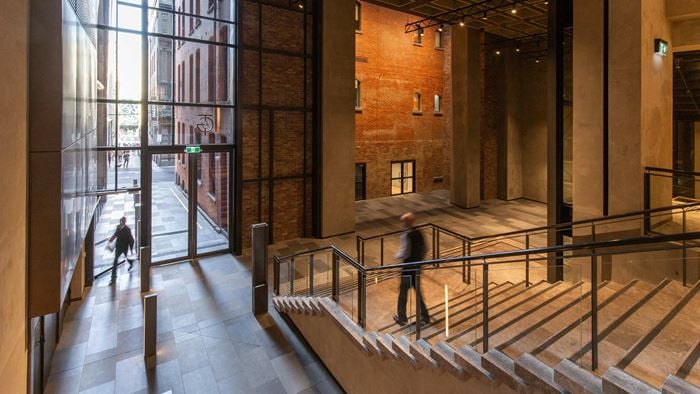For a new 40-story Manhattan office tower, our innovative structural design delivered significant cost savings for the client.
Wind
As with all towers, performance under wind loading was a critical aspect of the structural design. We therefore worked with consultants RWDI to conduct a wind tunnel test at completion of the schematic design stage. The testing showed that while the overall loads were lower than the early code-based predictions, the accelerations were higher than predicted, largely because of both shielding and wake buffeting caused by surrounding buildings.
This made the building an ideal candidate for a damping system, which would both reduce the accelerations and, provided enough damping was added, allow us to reduce the amount of steel in the building to take advantage of the reduced overall loads.
We studied several damping systems, including tuned mass dampers and tuned liquid column dampers. However, reconfiguring the building to allow space for such systems would have cost valuable real estate at the top of the tower.
Instead, Arup designed an innovative damped outrigger system that replaces the rigid elements in the outriggers with seven viscous dampers. In this way, we delivered a similar level of damping as a tuned mass damper, without using any additional space or adding any weight to the building — and at less than half the cost of a tuned mass damper.
The resulting design was 10% lighter than a scheme with no added damping, saving 1,000 tons of steel, but with none of the drawbacks associated with conventional damping systems. This outcome far exceeded the client’s expectations.
“Our experience with Arup as structural engineer for 250 West 55th has been nothing but positive. Matt Jackson and his team ran an almost flawless process. The degree of coordination achieved with the Revit and Tekla models was extremely thorough, evidenced by the low number of RFIs (250) received for the entire steel fabrication and erection process. Arup showed creativity and a real willingness to help us achieve our goals for the design of 250 West 55th Street ” Robert Schubert Senior Vice President of Construction at Boston Properties
Complex analysis
The design of the viscous damping added complexity to the structural analysis. Because the damping system is integrated into the structure, it had to be analyzed with the structure, requiring techniques more normally used on seismic performance-based design projects.
Similarly, the specification of the dampers themselves was quite different to those used in seismic applications. In order to provide damping in moderate winds the dampers must cycle much of the time, but at very small amplitudes, leading them to leak over time.
Our solution was to use dampers with no seals (more commonly used in the aerospace industry), providing the owner with a long warranty and no maintenance.
3-D coordination
The design was driven to maximize both structural and programmatic efficiency from the start. The entire team used Revit from the schematic design stage, enabling tighter coordination of all the critical dimensions. This model was passed down to the contractor, who followed an extensive 3-D coordination process with all the principal trade subcontractors. An expedited steel shop drawing review process was also followed by reviewing the Tekla model ahead of receiving any piece drawings.
This process sped construction and reduced field issues, allowing the project to keep ahead of schedule.
Unusual construction circumstances
The 2008 economic crisis presented the very unusual problem of how to delay construction for an unknown length of time. We drew up a plan allowing for the orderly completion of the structure to grade, followed by waterproofing the site, completed by the end of 2009. The steel fabrication was completed and stored in a field in South Carolina, and a restart manual put together.
When the time came to restart construction in 2011, our earlier work made it possible for the steel erection to be mobilized quickly. One unusual question the process raised, however, was how two years of exposure to the elements would affect steel connections. This is outside of anything codes allow, and was a concern particularly for connections that had a special surface preparation.
To address this concern we carried out a series of tests from selected samples and were able to demonstrate that the friction coefficient was actually higher than freshly prepared control samples.





